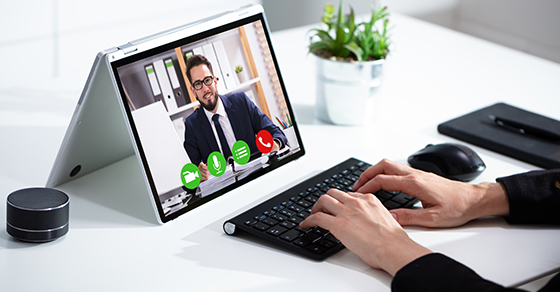
Are You and Your Financial Professionals Ready for a Remote Trial?
During the COVID-19 pandemic, the legal community has recognized that a physical presence may not necessarily be required in various legal situations, such as signing documents and testifying in court. This change has generally reduced travel costs and professional fees, while improving efficiency. Instead of paying for plane tickets and lodging and transferring boxes of documents, financial professionals may appear on a computer screen and look through documents with file-sharing tools.
This trend could potentially continue even after COVID-19 is contained. But transitioning from in-person to remote work arrangements may require professionals to hone new technology and communication skills. Here’s how to help prepare for the new normal.
Going Virtual
The U.S. Tax Court closed its building in March, though judges have continued to issue opinions throughout the first half of the year. In May, the Tax Court adopted procedures for conducting remote proceedings amid the pandemic. Trial sessions are expected to go remote this fall using Zoom for Government.
In accordance with recently issued Tax Court procedures, the parties will receive a court order that provides instructions on how to access the remote proceeding, including dial-in information, the meeting ID and a password. The court recommends that the parties log on and test their connections at least 30 minutes before the proceeding’s scheduled time. Like most court sessions, remote proceedings will be open to the public in real-time.
Across the country, many other courts have announced similar plans through year end. In fact, the U.S. court system now has funding specifically for instating video conferencing technology under the Coronavirus Aid, Relief and Economic Security (CARES) Act.
Key Difference
Remote trials are part of a larger trend toward virtual work arrangements. But the transition from in-person to virtual testimony hasn’t been as seamless as for virtual meetings or e-signatures.
We’ve all witnessed unexpected disruptions during virtual business meetings, such as rustling papers, crosstalk and faltering Internet connections. However, people tend to be more forgiving in informal settings. Trials and depositions are more formal. There’s only one chance to make a good impression during a hearing, and distractions can quickly discredit an expert witness’s professionalism and credibility.
An expert’s conclusions also may be muddied if technology malfunctions. For example, a judge may lose interest or patience if there are delays due to buffering during an expert’s testimony.
|
Supplement Remote Testimony with Written Reports
The move to virtual testimony underscores the importance of having a comprehensive written report that explains how the expert arrived at his or her conclusions. In U.S. Tax Court, written reports are typically used in lieu of direct testimony, but cross examination testimony may be done remotely using Zoom for Government videoconferencing technology.Other courts may give expert witnesses the option to submit written reports. In these situations, some may be accustomed to relying on only oral testimony to save costs and introduce an element of surprise into court proceedings. However, this strategy often backfires.A comprehensive written report gives the trier of fact a resource to refer to during deliberations — which, in larger cases, may occur days or weeks after the expert testifies. The report typically explains:
|
Best Practices
To avoid potential pitfalls, consider conducting test runs and using remote technology and collaboration tools during the pretrial phase to work out any kinks before the hearing begins. Attorneys and their professionals may need to troubleshoot existing software and audio quality, install updates, and/or invest in new software and equipment, such as cameras, microphones and remote headsets.
When preparing for a remote trial, consider these tips:
- Remote sharing of demonstrative exhibits, if allowed, should be practiced before trial to avoid unnecessary delays.
- Be sure that the platforms you’re using sync with courtroom technology.
- Silence all sounds on your devices — like email and instant messaging alerts — during the hearing. Even buzzing from a cellphone can cause the expert to lose his or her train of thought.
- Pause before starting to speak to accommodate any lags in remote audio technology. You don’t want to talk over other participants, especially the judge.
- Always use the mute button when you’re not speaking.
A general rule of thumb when using technology is: Expect the unexpected. Anticipate possible glitches and develop a backup plan. For example, you and your expert should have a secondary source of Internet service (like a hot spot on your cell phone), a backup battery (in case of power outages) and alternate hardware devices (such as laptops, tablets, smart phones, microphones and cameras) that can be powered up in a pinch.
Audio vs. Video Testimony
Though some judges prefer telephone or audioconferences, the use of up-to-date videoconferencing technology can help retain the intangible aspects of in-person testimony. For example, high-definition video-conferencing equipment can detect slight physical changes, such as smirks, eyerolls, wrinkled brows and even beads of sweat. These nonverbal cues may be critical to assessing an expert’s honesty and reliability, especially during cross examination.
When preparing for a video presentation, encourage your expert to maintain “eye-contact” with the camera, rather than reading entirely from his or her notes. This means looking directly into the camera — not the computer screen — which can take some getting used to.
It’s also important to evaluate the background that will appear behind your expert as he or she testifies. The background should look professional, even if the expert works from a home office. Be sure it’s free from distractions, such as family pets, doorbells, clutter and personal items. Heavy backlighting and windows can become distracting, too.
Changing Times
It’s unclear how long the pandemic will last. But, in legal proceedings, the show must go on. Though the legal industry has close ties to tradition and legacy processes, the pandemic may prompt courts to consider the benefits — to health, safety and efficiency — that remote technology offers. After the dust settles, remote legal processes and expert relationships may become commonplace.